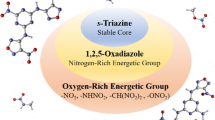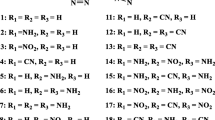Abstract
Metal complexes of Nickel and Copper with the dianion of bidentate chelating agent BTA [N,N-bis(1(2)H-tetrazole-5-yl)-amine] along with NH3 and NH2NO2 ligands were designed. A total of four metal complexes having the compositions such as M(BTA)(NH3)(NH2NO2) and M(BTA)(NH2NO2)2 where M is the metal atom, were formulated and subjected to detailed theoretical study to explore their energetic properties. Density Functional Theory (DFT) was used to predict the optimized geometry of the complexes at TPSS / 6-311G(d,p) level. The heats of formation of the metal complexes were determined using atomization method. Crystal densities of the salts were predicted using the data obtained at B3PW91 /6-31G(d,p) level utilizing the wave function analysis (WFA) program. Results indicate that all the designed compounds possess density in the range of 2.18–2.25 g cm−3. This is the remarkable feature of the title compounds because loading density is one of the desired properties for increasing the detonation performance of energetic materials. The calculated impact sensitivities (h50, cm) show that the three of the designed compounds are comfortably insensitive towards impact (h50,cm ∼42) in comparison to the experimentally determined values for the commercially used powerful explosives such as RDX (24–28 cm) and HMX (26–32 cm). Ni(BTA)(NH2NO2)2, the fourth designed compound has a value almost similar to that of RDX and HMX. The calculated detonation parameters D (detonation velocity) and P (detonation pressure) are predicted to be in the range of 7.7–8.5 km s−1 and 29.5–36.1 GPa, respectively. Results obtained in the present study predict that the designed compounds can be used as high energy density materials (HEDs).

Computational studies on Ni and Cu complexes containing BTA and NH2NO2 ligands show that these complexes possess the potential for use as high energy materials. The calculated densities of these metal complexes were estimated to be in the range of 2.18 to 2.25 g cm-3. The calculated detonation parameters put these complexes in the category of HEDMs.




Similar content being viewed by others
References
Li F, Bi Y, Zhao W, Zhan T, Zhou Z and Yang L 2015 Inorg. Chem. 54 2050
P Politzer and J S Murray 2003 (Eds.) Energetic Materials: Part I (Amsterdam: Elsevier)
P Politzer and J S Murray 2003 (Eds.) Energetic Materials: Part II (Amsterdam: Elsevier)
Singh H J and Upadhyaya M K 2013 J. Energetic Mater. 31 301
Singh H J, Gupta S and Sengupta S K 2015 RSC Adv. 4 40534
Mondal T, Saritha B, Ghanta S, Roy T K, Mahapatra S and Durga Prasad M 2009 J. Mol. Struct. THEOCHEM 897 42
Dippold A A and Klapötke T M 2013 J. Am. Chem. Soc. 135 9931
Gao H and Shreeve J M 2011 Chem. Rev. 111 7377
Ruiz G J C, Holl G, Karaghiosoff K, Klapötke T M, Lohnwitz K, Mayer P, Noth H, Polborn K, Rohbogner C J, Suter M and Weigand J J 2005 Inorg. Chem. 44 4237
Joo Y H, Twamley B, Garg S and Shreeve J M 2008 Angew. Chem. Int. Ed. 44 6236
Gobel M, Karaghiosoff K, Klapötke T M, Piercey D G and Stierstorfer J 2010 J. Am. Chem. Soc. 132 17216
Liao P Q, Zhou D D, Zhu A X, Jiang L, Lin R B, Zhang J P and Chen X M 2012 J. Am. Chem. Soc. 134 17380
Su C Y, Goforth A M, Smith M S, Pellechia P J and Loye H C 2004 J. Am. Chem. Soc. 126 3576
Aromi G, Barrios L A, Roubeau O and Gamez P 2011 Coord. Chem. Rev. 255 485
Li S, Wang Y, Qi C, Zhao X, Zhang J, Zhang S and Pang S 2013 Angew. Chem. Int. Ed. 52 14031
Zhang S, Liu X, Yang Q, Su Z, Gao W, Wei Q, Xie G, Chen S and Gao S 2014 Chem.-Eur. J. 20 7906
Stans M H 1970 NIST Special Publication 1 58
Friedrich M, Ruiz J C G, Klapötke T M, Mayer P, Weber B and Weigand J J 2005 Inorg. Chem. 44 8044
Guo Y, Gao H, Twamley B and Shreeve J M 2007 Adv. Mater. 19 2884
Klapötke T M, Mayer P, Stierstorfer J and Weigand J J 2008 J. Mater. Chem. 18 5248
Guo Y, Tao G H, Zeng Z, Gao H, Parrish D A and Shreeve J M 2010 Chem.-Eur. J. 16 3753
Dong L L, He L, Liu H Y, Tao G H, Nie F D, Huang M and Hu C W 2013 Eur. J. Inorg. Chem. 2013 5009
Lin J M, Guan Y F, Wang D Y, Dong W, Wang X T and Gao S 2008 J. Chem. Soc., Dalton Trans. 538 6165
Wang Y, Zhang J, Su H, Li S, Zhang S and Pang S 2014 J. Phys. Chem. A 118 4575
Tao G -H, Twamley B and Shreeve J M 2009 Inorg. Chem. 48 9918
Tao G -H, Parrish D A and Shreeve J M 2012 Inorg. Chem. 51 5305
Cook C, Habib F, Aharen T, Clérac R, Hu A and Murugesu M 2013 Inorg. Chem. 52 1825
Politzer P, Martinez J, Murray J S, Concha M C and Toro-Labbé A 2009 Mol. Phys. 107 2095
Bulat F A, Toro-Labbé A, Brinck T, Murray J S and Politzer P 2010 J. Mol. Model. 16 1679
Kamlet M J and Jacobs S 1968 J. Chem. Phys. 48 23
Tao J, Perdew J P, Starroverov V N and Scuseria G E 2003 Phys. Rev. Lett. 91 146
Rydberg P and Olsen L 2009 J. Phys. Chem. A 113 11949
Rayon V M, Valdes H, Diaz N and Suarez D 2008 J. Chem. Theory Comput. 4 243
Frisch M J et al., Gaussian 09 Version A.01 (Wallingford CT: Gaussian Inc.) (2009)
Shu Y, Li H, Gao S and Xiong Y 2013 J. Mol. Model. 19 1583
Pospíšil M, Vávra P, Koncha M C, Murray J S and Politzer P 2010 J. Mol. Model. 16 895
Dennington R, Keith T and Millam J 2009 GaussView Version 5 (Shawnee Mission KS: Semichem Inc.)
Qiu L, Xio H, Gong X, Ju X and Zhu W 2006 J. Phys. Chem. 110 3797
Rice B M, Sahu S and Owens F J 2002 J. Mol. Struct. THEOCHEM 583 69
Cary F A and Sundberg R J 2000 In Advanced Organic Chemistry: Part A: Structure and Mechanisms (New York: Kluwer) p.217
Luo Y-R 2007 In Comprehensive Handbook of Chemical Bond Energies (Boca Raton Florida: CRC Press)
Rice B M and Hare J J 2002 J. Phys. Chem. 106 1770
Acknowledgements
Authors are thankful to Uttar Pradesh State Government for providing financial support under its Centre of Excellence Program. Thanks are also due to DRDO, Ministry of Defence for financial help in the up-gradation of the computational facility.
Author information
Authors and Affiliations
Corresponding author
Additional information
Supplementary Information (SI)
All the detailed information regarding the calculation of heat of formation using atomization method (S1), estimation of heat of detonation (S2), electrostatic parameters for the evaluation of impact sensitivity and crystal density (Table S1), atomic coordinates for the minimized structures (Tables S2–S5), electronic energy of the molecules (Table S6), and optimized structures of the designed complexes, A1, A2, B1 and B2 (Figure S1) are given in the Supplementary Information, available at www.ias.ac.in/chemsci.
Electronic supplementary material
Below is the link to the electronic supplementary material.
Rights and permissions
About this article
Cite this article
SHARMA, P., SINGH, H.J. & SENGUPTA, S.K. Theoretical studies on BTA-Metal (M=Ni, Cu) Complexes as High Energy Materials. J Chem Sci 128, 1923–1932 (2016). https://doi.org/10.1007/s12039-016-1185-y
Received:
Revised:
Accepted:
Published:
Issue Date:
DOI: https://doi.org/10.1007/s12039-016-1185-y




